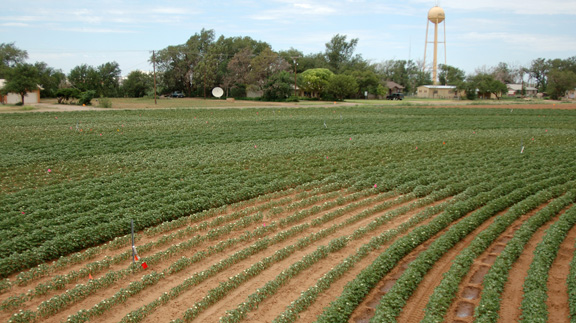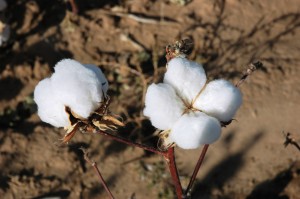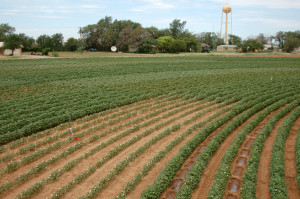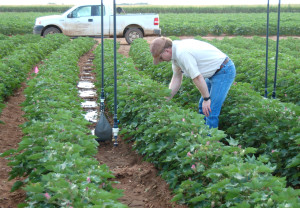Farm & Ranch
AgriLife Today Researchers: High Plains cotton production can survive predicted climate changes

By: Kay Ledbetter
Writer: Kay Ledbetter, 806-677-5608, [email protected]
Contact: Dr. Srinivasulu Ale, 940-552-9941, [email protected]
Dr. Pradip Adhikari, 940-552-9941, [email protected]
James Bordovsky, 806-746-6101, [email protected]
VERNON – Cotton production in the Texas High Plains can survive expected climate changes, especially if water is available to compensate for higher temperatures, and increased atmospheric carbon dioxide concentrations can mitigate yield loss in the dry years.
That was the conclusion of a Texas A&M AgriLife Research study, “Simulating future climate change impacts on seed cotton yield in the Texas High Plains using the CSM-CROPGRO-Cotton model,” recently published in the Agricultural Water Management journal.
“We believe cotton production in the Texas High Plains can withstand the effects of future climate variability under moderate increases in carbon dioxide levels,” said Dr. Srinivasulu Ale, AgriLife Research geospatial hydrologist in Vernon. “But our study shows that maintaining high yield levels will still require greater than 80 percent of current irrigation levels, even when increased carbon dioxide levels are accounted for.”
Joining Ale on the modeling study was Dr. Pradip Adhikari, AgriLife Research post-doctoral research associate in Vernon, and Jim Bordovsky, AgriLife Research senior research scientist and agricultural engineer in Lubbock/Halfway, among others.
The overall study was funded by Cotton Incorporated with model calibration partially supported by a Texas A&M Water Seed Grant.
Dwindling groundwater resources in the underlying Ogallala Aquifer, future climate variability and frequent occurrences of droughts are major concerns for cotton production in this region, Ale said.
He said it is known that climate change can affect agriculture both positively and negatively. Increases in carbon dioxide concentration due to climate change are positive for plant growth. Previous research reported elevated carbon dioxide levels could enhance crop growth and yield by increasing photosynthesis and decreasing stomatal conductance. As a result, transpiration per unit leaf area is reduced and overall water-use efficiency is improved.
“We know this region is predicted to have warmer summers and reductions in annual precipitation in the future,” Ale said. “Such trends would necessitate larger groundwater withdrawals to meet the higher evapotranspiration needs of cotton and prevent yield loss.”
That is why it is important to begin assessing the impacts of climate change on cotton production now to enable the development and evaluation of irrigation strategies for efficient utilization of groundwater resources in this region in the future, he said.
“Our study showed it may still be possible to produce cotton yields of 1,000 pounds of fiber per acre even under high deficit – 60 percent – irrigation,” Ale said.
In this study, the CROPGRO-Cotton model was evaluated for the Texas High Plains region using 27 treatments of measured data from cotton water-use efficiency experiments conducted from 2010-2013.
The measured data came from Bordovsky’s work at the Texas A&M AgriLife Research Center at Halfway and the impacts of future climate variability and change on irrigated cotton yield were assessed at Halfway and four other locations: Bushland, Lockney, Lubbock and Lamesa.
The future climate data used in this study was taken from research conducted by Dr. Naga Modala, also a co-author on the paper, while he was a graduate student in Ale’s program.
The evaluated CROPGRO-Cotton module withing the Cropping System Model was used to simulate the irrigated seed cotton yield under historic, 1971-2000, and future, 2041-2070, climate scenarios projected by three climate models, Adhikari said.
Simulated seed cotton yield matched closely with observed yield during model calibration and validation, he said. The evaluated model was able to accurately simulate seed cotton yield under various irrigation strategies over the four growing seasons.
The scenario examined the changes from 380 parts per million of carbon dioxide currently experienced to increasing levels of 493 parts per million in the year 2041 to 635 parts per million by 2070, which is the Intergovernmental Panel on Climate Change A2 emission scenario.
Also modeled in this study were the effects of reducing irrigation due to declining water levels, Ale said.
On an average, when compared to historic yields, simulated future yields across the Texas High Plains decreased within a range of 4-17 percent due to the combined effect of the increase in temperature and decrease in rainfall when carbon dioxide concentration was assumed to remain at the current level of 380 parts per million under three climatic model scenarios.
When the carbon dioxide concentration was assumed to increase from 493 parts per million in year 2041 to 635 parts per million in 2070, the simulated irrigated yields increased within a range of 14-29 percent as compared to historic average yield.
At the same time, when irrigation was reduced by 40 percent, the average 2041-2070 yields under the constant carbon dioxide concentration and the increasing concentration scenario decreased by 37 percent and 39 percent, respectively.
In general, average seed cotton yields under changing carbon dioxide concentration were higher by 11-15 percent when compared to constant carbon dioxide concentration among different irrigation levels. However, this trend varied among wet, normal and dry years, Adhikari said.
The percentage change in average seed cotton yield due to changing carbon dioxide concentration ranged between -9 percent at a 60 percent irrigation level and 7-8 percent at 100 percent irrigation level for the wet and normal years. It changed 30 percent and 98 percent at the respective irrigation levels for the dry years.
“These results imply that cotton is sensitive to atmospheric carbon dioxide concentrations, especially in dry years,” Ale said.
-30-
Find more stories, photos, videos and audio at http://today.agrilife.org
Farm & Ranch
Hazards of Backyard Poultry

By Barry Whitworth, DVM
Having backyard poultry is a popular agriculture enterprise. According to the United States Department of Agriculture, 0.8 percent of all households in the United States have chickens. People keep chickens for a variety of reasons with table eggs being one of the more common reasons.
Unfortunately, some of these poultry producers are not aware of the hazards that come with keeping poultry because many times they carry pathogens but appear healthy.
Chickens are carriers of several zoonotic diseases. These are diseases that can be passed from animals to humans. According to a recent survey in Pennsylvania, a majority of backyard poultry producers were aware of the dangers of avian influenza. However, this study also revealed that far fewer producers were aware of the risk of possible exposure to Salmonella and Campylobacter.
The lack of knowledge about the hazards of raising poultry likely contributes to the continued issues of Salmonella outbreaks associated with backyard poultry. In 2023, the Centers for Disease Control and Prevention reported 1,072 illnesses of Salmonella linked to backyard poultry, and 272 of those patients required hospitalization. Oklahoma reported 43 individuals with the disease.
To read more, pick up a copy of the April issue of NTFR magazine. To subscribe by mail, call 940-872-5922.
Farm & Ranch
Ag Elsewhere: Wyoming

By Tressa Lawrence
Babies are tucked away in every nook and cranny. Many ranchers across Wyoming have baby animals popping up all over this time of year.
Farm & Ranch
Ag Elsewhere: Montana

By Lindsey Monk
Another load of grain in to keep feeding the calves until the green grass can really start popping.
-

 Country Lifestyles1 year ago
Country Lifestyles1 year agoScott & Stacey Schumacher: A Growth Mindset
-

 Equine7 months ago
Equine7 months agoThe Will to Win
-

 Country Lifestyles7 years ago
Country Lifestyles7 years agoStyle Your Profile – What your style cowboy hat says about you and new trends in 2017
-

 Country Lifestyles4 years ago
Country Lifestyles4 years agoAmber Crawford, Breakaway Roper
-

 HOME7 years ago
HOME7 years agoGrazing North Texas – Wilman Lovegrass
-

 Country Lifestyles7 years ago
Country Lifestyles7 years agoDecember 2016 Profile, Rusty Riddle – The Riddle Way
-

 Country Lifestyles8 years ago
Country Lifestyles8 years agoJune 2016 Profile – The man behind the mic: Bob Tallman
-

 Outdoor9 years ago
Outdoor9 years agoButtercup or Primrose?









